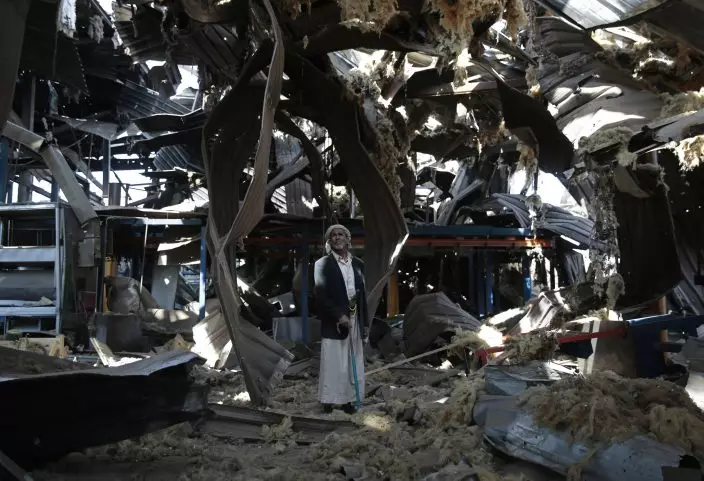The U.N. envoy for Yemen announced Friday the country's internationally recognized government and rival Houthi Shiite rebels have agreed to attend talks aimed at ending their three-year war, which has created the globe's worst humanitarian crisis by pushing the Arab world's poorest country to the brink of famine.
Martin Griffiths told the U.N. Security Council that he planned to bring the warring parties together "soon" in Sweden. He also said the Houthis and the government, which is backed by a Saudi-led coalition, were about to conclude an agreement on exchanging prisoners and detainees.
The spotlight has fallen on what many viewed as the long forgotten war in Yemen since the murder of Saudi journalist Jamal Khashoggi at Saudi Arabia's consulate in Istanbul on Oct. 2. Griffiths said he is determined to take advantage of "the international attention and energy" to move toward peace.

FILE - In this Aug. 13, 2018 file photo, Yemenis attend the funeral of victims of a Saudi-led airstrike, in Saada, Yemen. Airstrikes by Saudi Arabia and its allies in Yemen are on a pace to kill more civilians in 2018 than last year despite US claims that the coalition is working to prevent such bloodshed, a database tracking violence shows. The war, nearly four years old, may have killed as many as 80,000 people, according to the figures, not counting the untold numbers who have died of hunger in the humanitarian disaster wreaked by the conflict. (AP PhotoHani Mohammed, File)
"We must seize this positive international momentum on Yemen," he told the U.N.'s most powerful body. "This is an opportunity at a crucial moment to pursue a comprehensive and inclusive political settlement to the conflict."
Griffiths said preparatory issues for the meeting are close to being resolved and he has sent the parties his "vision" for "U.N.-led, inclusive Yemeni negotiations to end the war and restart a political transition process."
The conflict in Yemen began with the 2014 takeover of the capital of Sanaa by the Iranian-backed Houthis, which toppled the government of Abed Rabbo Mansour Hadi. The Saudi-led coalition allied with the government has been fighting the Houthis since 2015.

FILE - In this Sept. 22, 2016, file photo, a man stands among the rubble of the Alsonidar Group's water pump and pipe factory after it was hit by Saudi-led airstrikes in Sanaa, Yemen. The Saudi-led coalition fighting in Yemen said early Saturday, Nov. 10, 2018, it had "requested cessation of inflight refueling" by the U.S. for its fighter jets after American officials said they would stop the operations amid growing anger over civilian casualties from the kingdom's airstrikes. (AP PhotoHani Mohammed, File)
Saudi-led airstrikes have hit schools, hospitals and wedding parties and killed thousands of Yemeni civilians. The Houthis have fired long-range missiles into Saudi Arabia and targeted vessels in the Red Sea.
Civilians have borne the brunt of the conflict, which has killed over 10,000 people and created what the executive director of the U.N.'s World Food Program said Friday is "a catastrophe."
David Beasley, who just returned from a three-day visit to Yemen, told the Security Council that "we do not need to wait for formal declarations about famine or even a full report to act."

FILE - In this Oct. 14, 2016 file photo, fire and smoke rise after a Saudi-led airstrike hit a site believed to be one of the largest weapons depots on the outskirts of Yemen's capital, Sanaa. Airstrikes by Saudi Arabia and its allies in Yemen are on a pace to kill more civilians in 2018 than last year despite US claims that the coalition is working to prevent such bloodshed, a database tracking violence shows. The war, nearly four years old, may have killed as many as 80,000 people, according to the figures, not counting the untold numbers who have died of hunger in the humanitarian disaster wreaked by the conflict. (AP PhotoHani Mohammed, File)
"I believe that because of what I saw and heard this week children are already dying," he said.
Beasley warned that "starvation is on the horizon unless circumstances change — and change immediately."
Right now, he said, his agency is helping about 8 million people a month in Yemen but the situation has become "extremely dire."
"Of the 28 million Yemenis, we believe that as many as 12 million or more Yemenis — yes, that's right, almost half of the entire country — are just one step away from famine," Beasley said.
That number has doubled in the last year and a half and the situation is getting even worse, largely because of the collapse of Yemen's economy and the sharp decline in its currency, he said.
To avert famine, Beasley said, the international community must combine increased humanitarian funding with "an all-out effort to restore the Yemeni economy."
He said that will require scaling up assistance to help 12 million Yemenis, which would require about $150 million to $160 million a month. And it would require a cash injection of $200 million a month into Yemen's economy to stabilize its currency and stave off economic collapse, he said.
"Yemen is on the brink — so together we must act," Beasley said. Otherwise, he warned, "we will be in the position of deciding which children live and which children die."
U.N. humanitarian chief Mark Lowcock, who warned the council on Oct. 23 that the economic crisis and escalating conflict had pushed Yemen closer to famine than ever before, also urged its members to take action now.
In addition to also urging the parties to negotiate an end to the conflict and the international community to boost aid, he called for a humanitarian cease-fire around key aid facilities, delivery of humanitarian and commercial imports to all Yemeni ports and onward to their final destinations, and funding to pay Yemeni pensioners and civil servants.
Britain's U.N. ambassador, Karen Pierce, said she will circulate a Security Council resolution Monday to address the Yemen crisis and put Lowcock's requests "into practice."
U.S. deputy ambassador Jonathan Cohen told the council: "This war must end soon, and it won't end on the battlefield." He reiterated U.S. Secretary of State Mike Pompeo's words: "The United States seeks a cessation of hostilities in Yemen."
Lowcock noted that after an upsurge in fighting immediately after his Oct. 23 briefing to the council, there has been "a welcome de-escalation" in the last two days.
"But what we need to know is that this lull is going to be sustained," Lowcock said. "It remains urgent for the parties to agree a cessation of hostilities."
JACUMÉ, México (AP) — Near the towering border wall flanked by a U.S. Border Patrol vehicle, botanist Sula Vanderplank heard a quail in the scrub yelp “chi-ca-go,” a sound the birds use to signal they are separated from a mate or group.
Then silence.
A quail on the Mexican side called back, triggering a back-and-forth soundtrack that was both fitting and heartbreaking in an ecosystem split by an artificial barrier.
Vanderplank was among several botanists and citizen scientists participating in the Border Bioblitz near the Mexican community of Jacumé, about 60 miles (100 kilometers) east of Tijuana.
Roughly 1,000 volunteers armed with the iNaturalist app on their smartphones are documenting as many species as possible along the U.S.-Mexico border in May. Uploading photos to the app helps identify plants and animals, and records the coordinates of the location.
The hope is the information could lead to more protections for the region's natural richness, which is overshadowed by news of drug trafficking and migrant smuggling.
On a recent day, Bioblitz volunteers scrutinized a bright yellow blooming carpet of common Goldfields, a sharp contrast to the imposing steel bollards of the border wall topped with rolls of razor wire. Some navigated their way around piles of empty water jugs, a gray hoodie and empty cans of tuna fish left under the branches of native flora like the Tecate Cypress.
“There’s a fabulous amount of biodiversity here that’s traditionally been overlooked,” Vanderplank, of the binational program Baja Rare, said.
The efforts started in response to former President Donald Trump adding hundreds of miles of border walls that toppled untold numbers of saguaro cactuses in Arizona and passed through the biodiversity hotspot of Baja California.
“When the border wall construction began, we realized how little hard data we had, especially when it came to plants and small organisms,” Vanderplank said. “We don’t know what all we could lose.”
Since then, there has been a groundswell of initiatives to document the borderland’s flora and fauna as climate change coupled with habitat loss, pollution and development have hammered the world’s biodiversity. One estimate in 2019 warns that a million plant and animal species face extinction within decades, a rate of loss 1,000 times greater than expected.
The United Nations is expected hold a high-level meeting in Colombia of signatories to the Convention on Biological Diversity in October aiming to protect 30% of land, freshwater and oceans considered important for biodiversity by 2030, known as 30 by 30. Representatives from nearly 200 countries are expected to present plans on how they will meet conservation targets agreed upon in 2022.
Currently, 17% of terrestrial and 10% of marine areas are protected.
Baja California peninsula, which borders California and is home to Tijuana with one of Mexico's highest homicide rates, has more than 4,000 species of plants. A quarter of them are endemic and at least 400 plants are considered rare with little to no protection.
Flora and fauna that have gone extinct or are in danger of disappearing in the U.S., like the California red-legged frog, are thriving south of the border, producing specimens that are being used to bring back populations.
But the region’s crime deters many U.S. scientists from crossing the border. Mexico also is restricting permits for botanists and not allowing seeds to be collected, further curtailing the work, scientists say.
Bioblitz organizers work with local communities and say they take people only to areas deemed safe.
“You have to be really careful because of the violence,” said Jon Rebman, a curator of botany at the San Diego Natural History Museum, who has named 33 new plants for science from the southern California and Baja California region.
“It’s scary from that standpoint, yet those are the areas where we really need more information because there’s hardly any protected area on the south side,” he said.
Using the museum’s collection, Rebman made a list of 15 plant species endemic to Baja California and not seen since being collected nearly a century ago. He created a binational team to find them. So far, they have located 11.
Rebman also discovered two new plants to science in 2021 in a canyon off a Tijuana highway: the new species, Astragalus tijuanensis, and a new variety of the Astragalus brauntonii named lativexillum.
“I was worried they would go extinct before we even got them named,” Rebman said. “That tells you what type of area we’re working in.”
Tijuana-based botanist Mariana Fernandez of Expediciones Botánicas periodically checks on the plants. Working with Rebman, she is pushing Baja California to adopt more protections for its native plants. Currently only a fraction are on Mexico’s federal protection list.
She hopes the state will step in, while she also tries to build support by taking Tijuana residents and Baja officials on hikes.
“People are amazed that these things exist in Tijuana, and I hope to show more and more people so they can see the beauty, because we need that,” Fernandez said. “It’s important to not be impeded by the barriers that humans create.”
As border security increases with the number of people being displaced by natural disasters, violence and wars at record levels worldwide, more migrants are traipsing out to areas like the stretch near Jacumé. The tiny community of about 100 families includes members of the Kumeyaay tribe and sits across the border from an equally sparsely populated desert near the California town of Jacumba Hot Springs. Population: about 1,000.
The area has seen thousands of asylum seekers who wait for an opportunity to cross, usually in the cloak of darkness, and then camp again on the U.S. side after turning themselves in to U.S. Border Patrol agents.
Fernandez was among the botanists helping Bioblitz volunteers on the Mexican side near a crumbling crossing station from the 1920s.
“I never would have thought that there would be so much biodiversity on the border,” said Jocelyn Reyes, a student of Fernandez at La Universidad Autónoma de Baja California who stopped every few feet to hover over a plant and photograph its details. “It’s so interesting and makes you realize there’s so much worth saving.”

A California Horned Lizard is temporary held for classification during a botanical expedition with Universidad Autonoma de Baja California college students documenting native plants and species along the U.S.-Mexico border on Friday, April 19, 2024, in the Ejido Jacume in the Tecate Municipality of Baja California, Mexico. Botanists and citizen scientists armed with the iNaturalist app on their smartphones are recording the biodiversity along the U.S.-Mexico border in May. Called the Border Bioblitz, more than 1,000 volunteers are recording as many species as possible. (AP Photo/Damian Dovarganes)

Horses walk close to the US Mexico border Friday, April 19, 2024, in the Ejido Jacume in the Tecate Municipality of Baja California, Mexico. Botanists and citizen scientists armed with the iNaturalist app on their smartphones are recording the biodiversity along the U.S.-Mexico border in May. Called the Border Bioblitz, more than 1,000 volunteers are recording as many species as possible. (AP Photo/Damian Dovarganes)

Dr. Georges Seingier, Prof. Marine and Environmental Sciences at Baja California Autonomous University joins a botanical expedition with Universidad Autonoma de Baja California college students to document native plants along the U.S.- Mexico border on Friday, April 19, 2024, in the Ejido Jacume in the Tecate Municipality of Baja California, Mexico. The group near the Mexican community of Jacume, about (60 miles) 100 kilometers east of Tijuana, is one of several participating in the Border Bioblitz in which more than 1,000 volunteers throughout May record as many species as possible along the U.S.-Mexico border, a region plagued by drug trafficking and migrant smuggling that have overshadowed its natural richness. (AP Photo/Damian Dovarganes)

College students, members of Baja California's conservation organization Baja Rare, lead a botanical expedition to document native plants along the U.S.-Mexico border on Friday, April 19, 2024, in the Ejido Jacume in the Tecate municipality of Baja Calif., Mexico. The Baja California peninsula, which borders California and is home to Tijuana, one of the deadliest cities in the world, has more than 4,000 species of plants. According to scientists, a quarter of them are not found anywhere else, and some 200 plants are considered rare with little to no protection. (AP Photo/Damian Dovarganes)

A college student joins members of the California's Baja Rare conservation project leading a botanical expedition to document native plants along the U.S.- Mexico border on Friday, April 19, 2024, in the Ejido Jacume in the Tecate Municipality of Baja Calif., Mexico. Since then there has been a groundswell of initiatives to document the borderland's flora and fauna as climate change coupled with habitat loss, pollution and development have hammered the world's biodiversity, with one estimate in 2019 warning that a million plant and animal species face extinction within decades, a rate of loss 1,000 times greater than expected. (AP Photo/Damian Dovarganes)

Dr. Georges Seingier, Prof. Marine and Environmental Sciences at Baja California Autonomous University leads a botanical expedition with Universidad Autonoma de Baja California botanists and citizen scientists to document native plants along the U.S.- Mexico border on Friday, April 19, 2024, in the Ejido Jacume in the Tecate Municipality of Baja California, Mexico. Since then there has been a groundswell of initiatives to document the borderland's flora and fauna as climate change coupled with habitat loss, pollution and development have hammered the world's biodiversity, with one estimate in 2019 warning that a million plant and animal species face extinction within decades, a rate of loss 1,000 times greater than expected. (AP Photo/Damian Dovarganes)

Members of the Baja California's conservation Baja Rare project lead a botanical expedition with college students to document native plants along the U.S.-Mexico border on Friday, April 19, 2024, in the Ejido Jacume in the Tecate Municipality of Baja Calif., Mexico. The group near the Mexican community of Jacume, about (60 miles) 100 kilometers east of Tijuana, is one of several participating in the Border Bioblitz in which more than 1,000 volunteers throughout May record as many species as possible along the U.S.-Mexico border, a region plagued by drug trafficking and migrant smuggling that has overshadowed its natural richness. (AP Photo/Damian Dovarganes)

Lichen grows on native tree branches along the US-Mexico border on Friday, April 19, 2024, in the Ejido Jacume in the Tecate Municipality of Baja California, Mexico. Botanists and citizen scientists armed with the mobile cellphone iNaturalist app are recording the biodiversity along the U.S.-Mexico border in May. The Border Bioblitz has more than 1,000 volunteers recording as many species as possible. Flora and fauna that have gone extinct or are in danger of disappearing in the U.S. have been found to be thriving in remote spots south of the border, producing specimens that can then be used to bring back populations, scientists say. But the region's crime has deterred many U.S. scientists from crossing the border. (AP Photo/Damian Dovarganes)

Botanists and citizen scientists armed with the iNaturalist app on their smartphones record the biodiversity along the U.S.-Mexico border as bright yellow blooms carpet the ground, a sharp contrast to the imposing steel bollards of the border wall topped with rolls of razor wire as members of the California's Baja Rare project lead a botanical expedition with college students to document native plants along the US Mexico border on Friday, April 19, 2024, in the Ejido Jacume in the Tecate Municipality of Baja Calif., Mexico. (AP Photo/Damian Dovarganes)

Tijuana-based field botanist Mariana Fernandez of Expediciones Botanicas leads a botanical expedition with college students to document native plants along the U.S.- Mexico border on Friday, April 19, 2024, in the Ejido Jacume in the Tecate Municipality of Baja California, Mexico. Flora and fauna that have gone extinct or are in danger of disappearing in the U.S. have been found to be thriving in remote spots south of the border, producing specimens that can then be used to bring back populations, scientists say. But the region's crime has deterred many U.S. scientists from crossing the border. (AP Photo/Damian Dovarganes)

Botanists and citizen scientists armed with the iNaturalist app on their smartphones record the biodiversity along the U.S.-Mexico border as bright yellow blooms carpet the ground, a sharp contrast to the imposing steel bollards of the border wall topped with rolls of razor wire along the US Mexico border on Friday, April 19, 2024, near Botanists and citizen scientists armed with the iNaturalist app on their smartphones record the biodiversity along the U.S.-Mexico border as bright yellow blooms carpet the ground, a sharp contrast to the imposing steel bollards of the border wall topped with rolls of razor wire as members of the California's Baja Rare project lead a botanical expedition with college students to document native plants along the US Mexico border on Friday, April 19, 2024, near the Ejido Jacume in the Tecate Municipality of Baja Calif., Mexico. (AP Photo/Damian Dovarganes)

Bright yellow blooms carpet the ground, a sharp contrast to the imposing steel bollards of the border wall topped with rolls of razor wire as members of the California's Baja Rare conservation project lead a botanical expedition with botanists and citizen scientists to document native plants along the U.S.- Mexico border on Friday, April 19, 2024, in the Ejido Jacume in the Tecate Municipality of Baja Calif., Mexico. (AP Photo/Damian Dovarganes)
























